Have you noticed yellow leaves on your fruit tree and wondered what causes fruit tree leaves to turn yellow?
They’re one of the typical autumn features you can expect to see in your fruit trees. But changing of the season is not the only cause of fruit tree leaves turning yellow.
Estimated reading time: 7 minutes
Yellow leaves on fruit trees are a common concern for gardeners, but understanding the underlying causes is key to maintaining healthy trees.
While seasonal leaf yellowing in autumn is completely normal as trees enter dormancy, yellow leaves appearing at other times can indicate issues that need attention.
The four main causes of fruit tree leaves turning yellow include natural seasonal changes, water stress from drought or overwatering, nutritional deficiencies (particularly iron, manganese, or zinc), and viral diseases like apple mosaic virus. By identifying which factor is affecting your fruit trees, you can take appropriate action to restore their health and ensure continued fruit production.
This guide will help you diagnose the specific cause of yellow leaves on your fruit trees and provide effective treatment solutions.
Autumn equals yellow leaves
The most common causes for fruit tree leaves to turn yellow, is the changing of the season to Autumn. It’s also not unusual to see fruit tree leaves start to turn yellow even when it still feels quite summery. For example, it often begins to happen on a tree that’s been fully harvested.
In our orchards, we’ve noticed that the typical pattern is that the leaves stay green and keep doing their job while the tree still has fruit on it.
But as soon as we’ve picked the fruit (often within days) the leaves start to go yellow. This is because the tree has started to go into “senescence”, or winter dormancy.
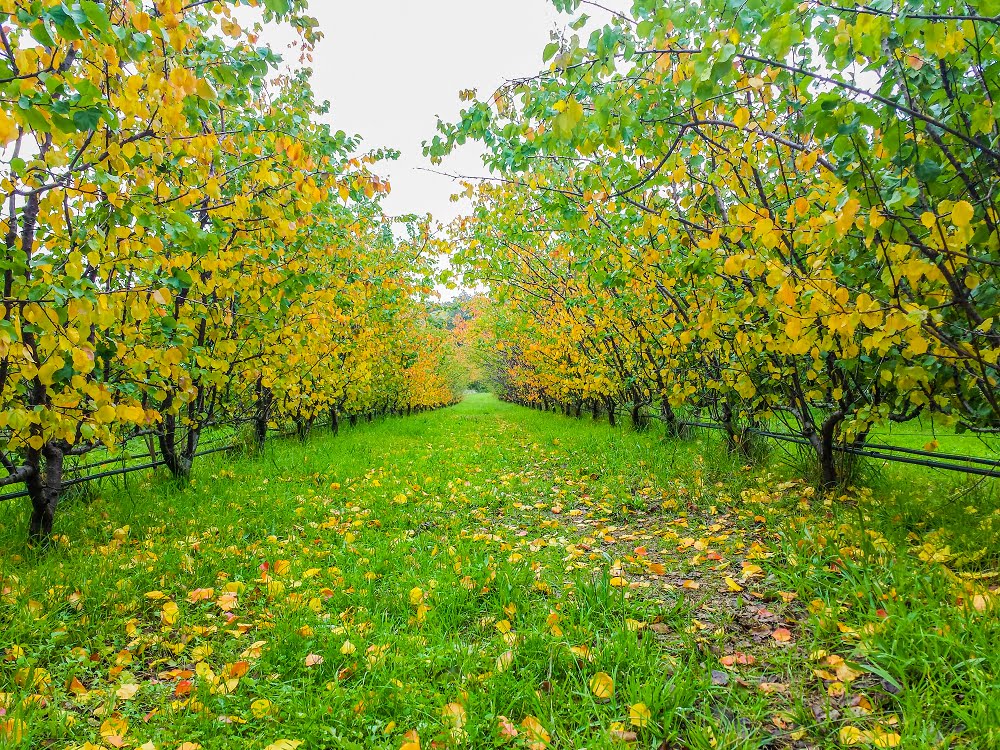
At that time, the tree starts to withdraw all the nutrients from the leaves back into the buds and bark. The first sign of this happening is the leaves changing colour.
This type of yellowing is completely normal, and you see it every year. However, there are lots of other causes for yellow leaves, including various diseases. It can also be due to something as simple as water!
Yellow leaves can be a sign of a lack of water
We’ve seen other causes for yellowing leaves over the years. One that is of more concern is a lack of water. You can see the classic symptoms on this cherry tree.

We always feel terrible when we spot a tree like this in the orchard because it’s completely under our control! It should never happen, but of course it often does.
It’s too easy for this to happen when you have an automatic irrigation system. Drippers can easily block up, and unless you’re checking them regularly (which is a good idea), you might not realise you have a problem.
But don’t worry, the tree will start telling you loud and clear. The leaves will turn unseasonally yellow. The dead giveaway is that the leaves on all the other trees nearby are still green.
Is it too late to fix it once the leaves have turned yellow? Depending on how long the tree has been dry, and what part of the season you discover it, the leaves may not recover even if you start giving the tree water.
But that doesn’t necessarily mean the tree will die, and it definitely doesn’t mean that you shouldn’t bother giving it water!
Nutritional definiciences causing yellow leaves on fruit tree
Another common reason for leaves to turn yellow is nutritional deficiencies. We often see it on citrus trees, where it particularly shows up as yellow veins on the leaves.
If you live in a cooler climate like we do, this can be a normal response of citrus trees to cold winter weather. In that case, it often disappears when the weather warms up.

But it can also be due to a problem in the soil, and this is not restricted to citrus trees.
A number of nutritional deficiencies can cause yellow leaves as one of their symptoms. Some of these include iron (as you can see below), manganese, and zinc.
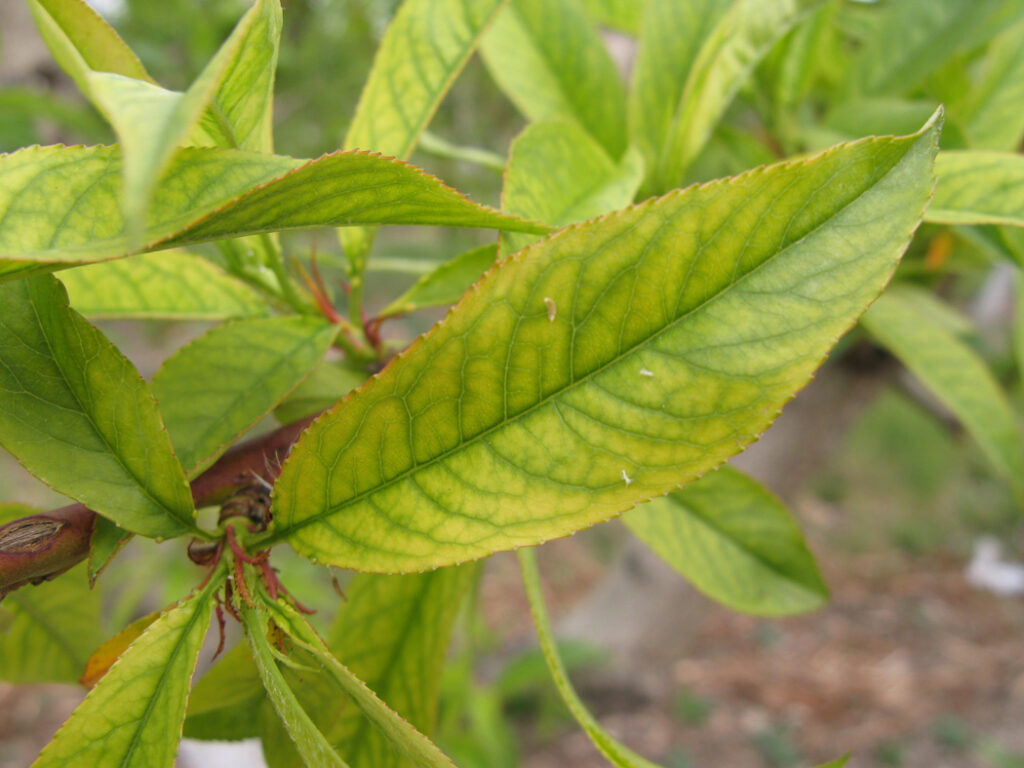
If your tree is showing these sorts of symptoms, don’t worry too much about exactly what the deficiency might be. Whatever it is, it’s a clear sign that the tree can’t get what it needs from the soil.
The answer? Feed the soil!
Fruit tree diseases that can cause yellow leaves
A fourth potential reason for yellow leaves is a virus disease, such as apple mosaic virus as you can see in this leaf.
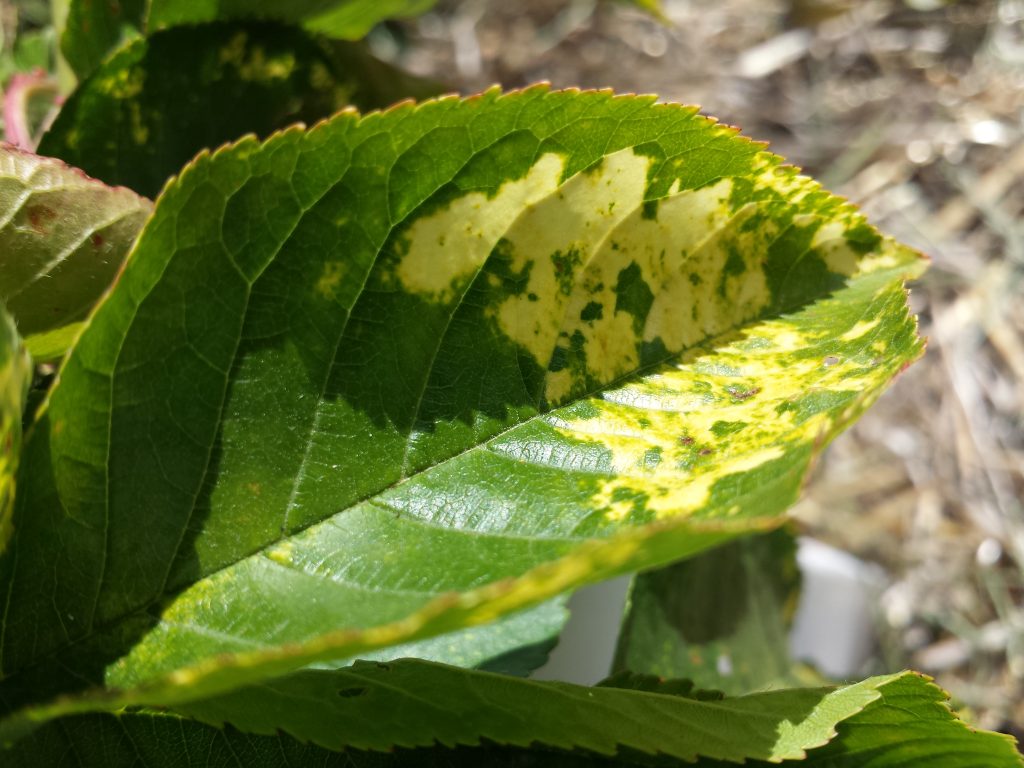
Viral diseases are not good news and unfortunately are not really treatable. The best bet is to look after the tree as well as you can and try to avoid the virus spreading.
A good tip is to avoid planting other trees of the same type nearby. This is one of the best fruit tree virus databases we know of.
So if the leaves on your fruit tree are turning yellow it may be a perfectly normal seasonal response.
But if you think it could be something else, you might need to do a little detective work to diagnose the problem, because your tree might also be trying to tell you something!
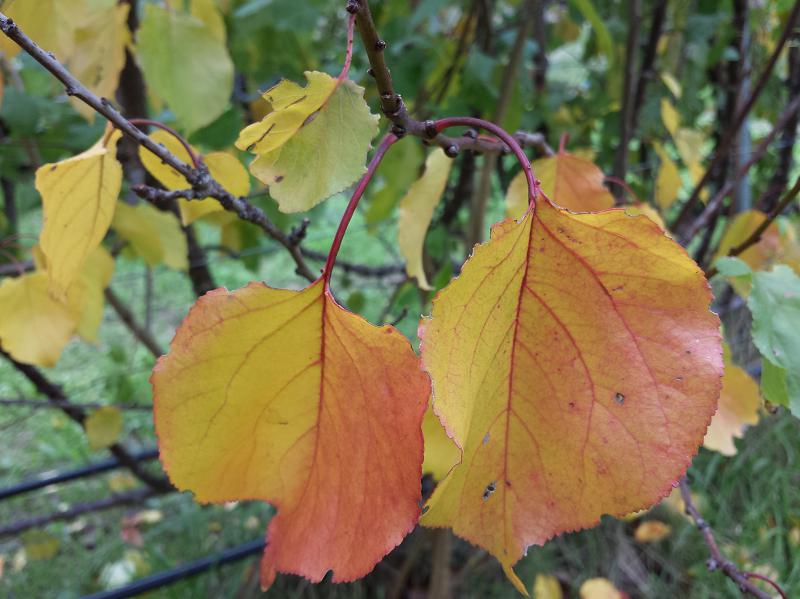
More helpful resources
Related Articles
How to use compost tea to fix yellow leaves on fruit trees
Compost tea is a great tool to help fix some of the causes of yellow leaves on your fruit trees by improving the health of your soil.
Peach Leaf Curl
Peach tree leaf curl disease is one of the main causes of curly leaves on your peach and nectarine trees, but it’s usually preventable.

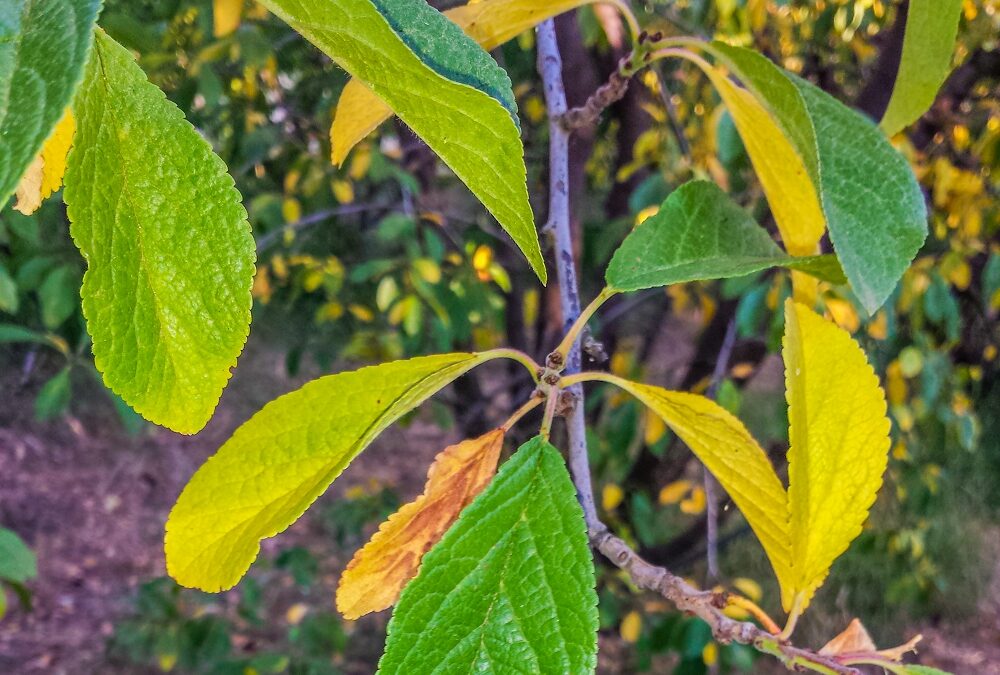
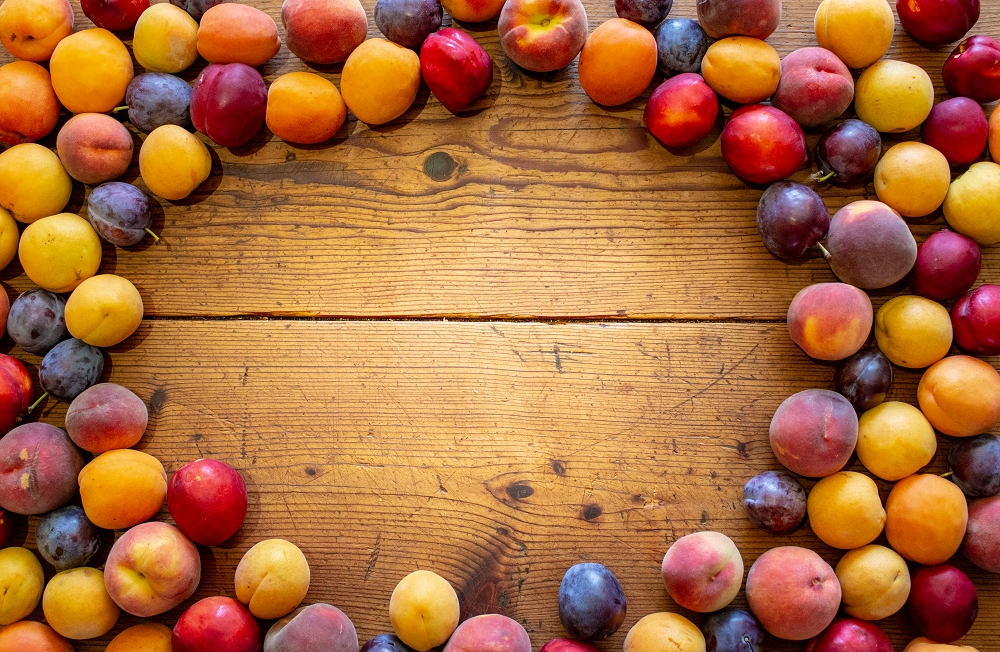
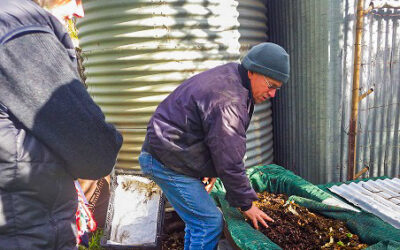
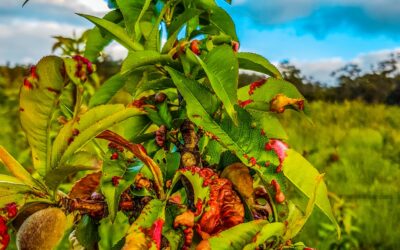

Hello
Have a 17 year old Opal plum tree. From the beginning of June the leaves have started yellowing and dropping. The tree is putting out new spurs that look healthy. Last year it produced an exceptional crop but for the first time suffered serious brown rot. It is an established tree and I can’t find out what the problem is. Would appreciate any advice, thankyou
Hi John, it’s a bit hard to answer this without more info – what country/state are you in?
Hello,
I have two 5 years old peach trees in hamilton Ontario Canada.
1 of them get dry while blooming after winter and 2nd tree bloom well and also have lot of fruit on it. But the fruit start creating gummy stuff and then all the leafs getting full yellow and dropping down and the fruit also start shrinking and getting dying.
I am unable to understand this disease, Please advise me how can I protect my tree I am very thankful for your kindness. If some how I can share pictures with you?
Hi Zaheer, without doing a proper consultation it can be hard to diagnose the exact problem – it could be lack of pollination if there’s not enough pollinators (like bees) around when the trees are flowering. Also pay attention to the soil – give it some good quality compost or worm castings. And make sure the trees get regular water so the soil is not too dry or too wet, all the time. You might find our two ebooks on pests and diseases helpful to help you identify what’s going on – https://growgreatfruit.com/product-category/ebooks/. Best of luck with your trees.
I am desperate and new to Apple tree growing. I can’t tell if my leaves have a fungi or too much or too little water. Several trees were planted in the spring and are considered young adult trees. I can send pictures but don’t know how. The leaves are a bit yellow with browning edges and or holes.
Hi Justin D, welcome to the website! So glad you found us, sounds like you need some help right now. Have you checked out our short courses? Have a look at the one about monitoring your trees, that will help you get started. Also, maybe do our free webinar to point you in the right direction. Talk soon!
I am new to planting trees and I have a small garden area. I want to start an orchard and have a dwarf mandarin, dwarf blood orange tree, two blueberry bushes, an Indigenous plum tree, a lemonade tree but I don’t know how far apart to plant them from each other. I do have a lemon tree but it’s it another part of my garden. I would like to plant dwarf apricot and other citrus trees. Thank you for your help.
Hi Jennifer, welcome to fruit growing, you’re going to have lots of fun! The rule of thumb is about 2.5m between trees, but it depends a little on things like how much room you have, the rootstocks the trees are on, whether you’re planning to net the trees etc. Probably the best short course for you to get started would be this one on Home Orchard Design: https://growgreatfruit.com/product/home-orchard-design/
Justin, did you figure out what was wrong with your tree. My peach tree is doing the same thing. The newer leaves are yellow and brown around the edges. The older leaves are still green. It’s a heavy laden 10 year old peach tree.
I’m new to planting fruit trees I only have a small area which I have a dwarf mandarin, dwarf blood orange an Indigenous plum tree and two blueberry bushes which I’d like to plant in an orchard like area but am unsure how far apart I should plant tree away from each other.
My nashi has some leaves, not all, with pale green “veins” like something drawn out of the leaves? but from outside…centre vein area still green. Have just fed with some cow poo…has been well watered? Castlemaine 🙂
Hi Chris, that sounds like a nutritional issue you’ve got going on there, possibly magnesium or manganese deficiency. It doesn’t really matter what it is, the point is to keep boosting your soil. Cow poo is a great idea, but we’d also suggest regular applications of really good compost , or even better – some worm castings. Plus a watering with seasol and charlie carp might be a good idea.
I just discovered my apple trees both on pots on separate places, have leaves turning pure yellow, it’s scary, for two years these beauties, grown from seed were perfect. Since it happened to both in separate pots, i think it’s nutritional. What should i give them to fix this?
Hi Monica, it may just be autumn calling, but it’s not a bad idea to give them a nutritional boost at this time of year anyway. Good quality compost is always a winner, worm castings are even better, and a dose of liquid fish and liquid seaweed (both easily available) is a great idea too. Pots are great for fruit trees but they do need regular nutrition because they’re not in touch with the earth. A couple of words of caution with apple seedlings – they don’t grow fruit that is “true to type” (but it’s easy to graft them if the fruit they produce isn’t nice to eat), and they usually become very large trees, so it’s best to plan to plant them in the soil sometime, or have them in quite large pots. We have a book on growing fruit trees in pots coming out soon!
I have two peach trees side by side in my yard. Same variety, planted at the same time, same age, and they get the same amount of water. One tree’s leaves are turning yellow and dropping. Any thoughts on why? and what I can do about it?
How interesting fruit trees are, Marie! Do you mean one of the trees is prematurely losing its leaves, or just going yellow earlier in autumn? If you’re positive they’re the same variety (and both are grafted, and on the same rootstocks), then it’s either due to some genetic variation in the tree (or a variation in the soil), or one of the trees is sick. Are there any other symptoms?
Hi there! Looking for some advice on my very old apple tree. I’m new to this as we just bought the property last April 2020. The tree last season produced a huge amount of apples and was full of green leaves and blossoms. The tree had so many apples the limbs were drooping. This year however the tree is less full and had fewer blossoms. The leaves are turning yellow with green veins. Also the tree seems to have some slight sticky sap coming out of it in 2 places. I’m concerned there may be some disease. So sad there are practically no apples.
Hi Supatra, congratulations on your new property. It’s so special to become the custodian of an old fruit tree, but there’s also so much to learn – we have two free workshops that can help with this (https://growgreatfruit.com/webinar-landing/).
The fact it fruited last year is a great sign – one of the things you’ll need to learn about is fruit thinning because fruit trees tend to biennial bear if you don’t remove quite a bit of fruit when they have a heavy crop. However, judging by what you say about the leaves turning yellow we’d recommend you start with soil health, as the tree might need a nutritional boost – if you search on ‘soil’ in our short course library you’ll find lots of resources. The other thing to check is whether the tree is getting enough water. The sticky sap may be indicative of a disease, but is probably not the reason for the yellow leaves or lack of fruit this year.
I have a potted nectarine and cherry tree. The tiny baby new leaves are turning yellow. To much water or not enough?
Without knowing how much water you’re putting on your trees this is a tricky one to answer – but it’s really easy to figure out how much water your trees need. Everything you need to know is in this short course – https://growgreatfruit.com/product/be-a-wise-water-warrior/. Good luck with your trees!
Hi. I was able to germinate 10 apricot trees from seed. They grew well and have been transplanted to gallon pots and are in my greenhouse. I live in an area that gets a lot of fog, but when the sun does shine it gets pretty hot in the greenhouse. I planted them in “planting soil” which is top soil mixed with compost. They have been doing well and growing nicely for about a month or so (since April). Now the leaves are turning yellow-ish. Am I watering them too much? Or maybe they need nutrients? Can you help me?
Thanks
Hi Maura, sounds like a great project. Could it be that the rootstocks are simply heading into dormancy with the winter season? If not, then definitely checking the moisture in your growing medium regularly is a good place to start, and making sure any containers are sitting in water is essential for your potted trees. That’s where we would start to figure out if there is a problem. Thanks – Meg, Grow Great Fruit team.
Cherry trees start to get sticky in june and leaf stems become black. Any idea what it cold be? No sap oozing on trunk.
Hi Peter – which part of the world are you in? Winter or summer? Sticky can be a telltale sign for aphids (more in this blog over here), but you’d probably see other signs too. You might find our free pest & disease webinar helpful to get you started in diagnosing too – https://growgreatfruit.com/pest-and-disease-webinar/. Thanks, Meg – Grow Great Fruit team
I recently planted a pink lady and a red delicious in my front yard. I live in Connecticut and the pink lady which I staked down after it started blowing in a couple of storms. There are about ten yellow leaves on the tree. My first thought that it is because it was being blown so the roots couldn’t settle. Also, the other tree is fine. I also put some fruit tree spray on them a week ago.
I have what I think is mosaic on my fig…it was here when I bought the place and has been okay for 12 or so years but noticed last summer it has mottled leaves and the fruit has light brown papery parts to the skin…have looked it up but not much info on the leaves…whether the virus can spread from them to other trees…not fig. Also one thing said to work on the soil and another, like you said you can’t do much….? Do I have to remove the tree?
Hi Chris – fig mosaic can come and go and no, you can’t get rid of it without removing the tree. But, we would be inclined to support the health of the tree and keep it unless you were planning to use it for cuttings or grafting. Viruses are usually specific to a plant or genus, so unless you have other figs close by, don’t be too worried about it spreading. Good luck, Meg – Grow Great Fruit team.
I have a 20 years mango tree growing next to a mandarin tree. The mandarin is doing okay but the mango not. The leaves of the mango always have a black dots and the fruits as well. What I can do to save my mango tree?
Hi Emma – sounds frustrating! Have you tried our free Pest & Disease webinar? It might help you get started in working out what’s going on! Good luck, Meg – Grow Great Fruit team.
I missed site for downloading free e-book. May I order it, please. Thank you.
Rhonda
Hi Rhonda – if you head over to our home page, there is a Weekly Fruit Tips (our newsletter) sign-up pop-up, and the e-book is provided when you sign up for the newsletter. Enjoy! Meg – GGF team.
Hello,
I planted a 5 foot tall meteor cherry tree sapling in late May. I filled the hole below and around the root ball with good compost from my backyard pile, mixed with some berry fertilizer pellets. I watered it regularly, particularly during the dry heat spells we’ve had. The tree’s leaves are all yellow and dried out and falling off. Can you tell me what I could do to avoid losing it? Thank you
I have two 6 year old peach trees on my property. I have Fertilized and compost around them over the past years, but have yet to get any fruit on either of them. What could be the problem? I have plenty of pollinators in my yard.
Hi Karla, without seeing the tree it’s not possible to answer definitively, but I’d be looking at whether the tree has flowered and then not fruited, or not flowered at all. Depending on the answer, this would lead us down a few paths to figure out what’s going wrong (potentially looking at pruning, tree variety and pollination windows). Hope that helps! Meg – GGF team.
Hello
I have a 8 years old cherry tree. It got lots of fruits. It was doing very well with green and healthy fruits. But suddenly they are getting yellow.
What’s going wrong with the tree?
Thank you,
Hi Laila, if it doesn’t seem to be any of the reasons we mention in this blog, it might be because the fruit didn’t actually set, that’s quite common with cherries. This can be caused by not having a polliniser tree available (a different of cherry tree that flowers at the same time), or lack of pollinators like bees.